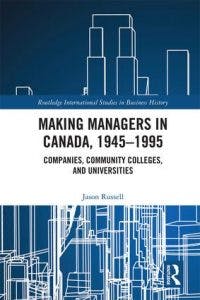
Book Review
Making Managers in Canada, 1945-1995: Companies, Colleges, and Universities, 2018
By Jason Russell
The foundational premise of Jason Russell’s 2018 book, Making Managers in Canada, 1945- 1995, is that following World War II management training became important to Canadian corporations. For the good of the firm, people already in management, and aspiring managers needed to be scientifically educated. This led to a variety of management and education programs being developed in Canada, for Canadians. Russell presents the histories of twelve separate Canadian management education programs offered by nine different institutions located across Canada, covering the time period 1945 to 1995. The MBA often seems to be the default and sole focus in studies of management education, yet managers are educated in a variety of institutions and formats. Russell goes well beyond graduate management education, and provides a glimpse into the worlds of industry-based, community college, undergraduate and graduate university management education in Canada. He studies management education and training programs at Bell Canada, The T. Eaton Company, Labatt Brewing, Vancouver Community College, Collége Ahuntsic in Quebec, Niagara College, the University of British Columbia, HEC in Montréal, and the University of Western Ontario.
Russell’s data comes from a variety of sources, mainly archival with the addition of three oral interviews. For community college and university programs Russell relied mainly on program guides and course calendars, drawing on program requirements, course descriptions, and photos, as well as reports and correspondence. Where possible he has traced course content through to the required textbook. For corporate training, Russell analysed audio, film, and print materials, some produced internally by the company, some created by academics, and some purchased from other companies, including industrial employers and production companies that specialized in training and education films.
A book or article covering any aspect of management from a solely Canadian perspective is unique and worth reading for those of us interested in management beyond the United States. Although rarely treated as such in management research, Canada and the United States are separate countries with distinct social contexts where both the education of managers and the practice of management are different. Russell discusses regional differences in Canada, such as differences in why and how British Columbia (BC), Quebec, and Ontario implemented and structured management education programs. He includes the key differences in post-secondary education in Quebec compared to the other provinces, going beyond language to an analysis of how Quebec colleges were intended to be a stepping stone to university, whereas Ontario and BC colleges were considered the final stop for a vocational education.
Russell also discusses how the types of education differed, positing that university programs were less influential than companies and colleges, as people in corporate and part-time college programs were already in, or being prepared for, management roles. His analysis of the programs shows that corporate training focused on people, community college students learned about being managers, and university programs taught about the functional areas of business with a shift from a liberal arts to a quantitative focus over the years. Russell offers a different perspective than the commonly held notion that graduate business education is the premier vehicle for delivering management capability – a perspective that we might encounter more often if research broadened its focus beyond the MBA. He also raises some interesting questions as to whether or not it’s possible to teach someone how to be a manager, or if managers are developed through experience.
Russell’s book leads me to wonder how, if it all, Canadian management education programs differed from programs in other geographic regions, such as the United States, Europe, South America, China, and India. He briefly states in the book that the curriculum of the Canadian programs was similar to that found in the United States and other countries, and that Canadian management education differs because of the environment in which it developed, including government involvement and bilingualism. Governments began developing management education at the college and university levels in response to provincial-level studies of higher education needs. As, for example, management education in the United States was developed mainly with private money, what influence did the government have on Canadian management education that resulted in differences from the United States? These types of questions can be asked about many aspects of management education. With this foundational text detailing multiple forms of Canadian management education, Russell opens the door for comparing, contrasting, and undertaking detailed analysis about how and why Canadian management is distinct from other countries.
Patricia Genoe McLaren
Wilfrid Laurier University